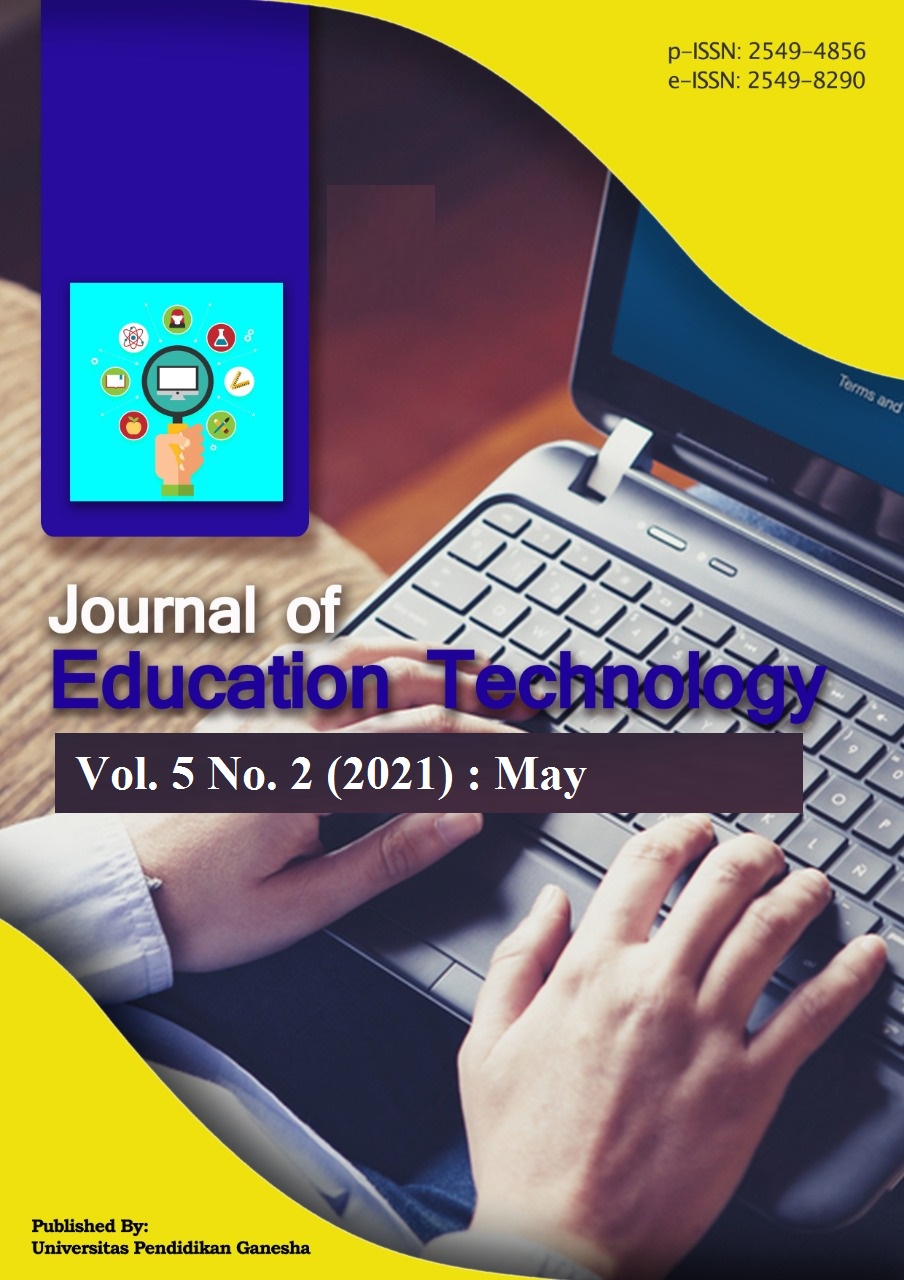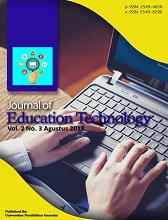Character Likes to Read in Elementary School Students Electronic Module and Print Module
DOI:
https://doi.org/10.23887/jet.v5i2.33834Kata Kunci:
Module, Local Wisdom, Love to ReadAbstrak
The low reading character is often found in the school environment. The low reading character is that many students read textbooks. This is due to the lack of exciting strategies to motivate students to read. This study aims to analyze the comparison of teaching materials, namely, comparing the print module and the electronic module. This type of research is comparative research. The method used in this study is a quantitative method using a survey research design. The sample of this study was the fourth-grade students who opened 22 people. Data analysis used descriptive, inferential statistics, namely analyzing data by describing the data that had been collected. The results of this study are from the two teaching materials that are applied, namely the printed module and the electronic module. It can see indicators of the reading habit. In the study, the dominant results were good for looking at indicators of reading fondness characters with the application of electronic modules. In contrast, for the application of print modules in the good category, from this it was seen that the difference between the two learning materials was applied to see indicators of reading fondness characters, this is with the results of the t-test which has been done, where the obtained is smaller than 0.05 then there is a difference between the two. So the electronic module based on local wisdom needs to be applied by teachers to instill the character of reading fondness among students.
Referensi
Anggreni, Wiarta, & Putra. (2020). Pengaruh Model Pembelajaran ( SAVI ) Berbasis ( TIK ) Terhadap Kompetensi Pengetahuan Matematika. Pedagogi Dan Pembelajaran, 3(1), 15–24. http://dx.doi.org/10.23887/jp2.v3i1.24357.
Antara, & Aditya, P. (2019). Pengaruh Model Pembelajaran Kontekstual Terhadap Kemampuan Membaca Permulaan Anak. Mimbar Ilmu, 24. http://dx.doi.org/10.23887/mi.v24i2.21263.
Aprilia, I., & Suryadarma, I. G. P. (2020). E-Module of Mangrove Ecosystem (EMME): Development, Validation, and Effectiveness in Improving Students’ Self-Regulated. Biosfer : Jurnal Pendidikan, 13(1), 114–129. https://doi.org/10.21009/biosferjpb.v13n1.114-129.
Ariana, Situmorang, & Krave. (2020). Pengembangan Modul Berbasis Discovery Learning Pada Materi Jaringan Tumbuhan Untuk Meningkatkan Kemampuan Literasi Sains Siswa Kelas Xi IPA SMA. Jurnal Pendidikan Matematika Dan IPA, 11(1), 34–46. http://dx.doi.org/10.26418/jpmipa.v11i1.31381.
Asna, & Mimi. (2016). Peningkatan Hasil dan Kemampuan Membaca Intensif Siswa Kelas IV pada Pembelajaran Bahasa Indonesia dengan Model Pembelajaran Word Square di SD Negeri 27 Batang Anai. Jurnal Konseling Dan Pendidikan, 4(2), 74 – 78. https://doi.org/10.29210/166%y.
Bravo, E. R., Santana, M., & Rodon, J. (2015). Information systems and performance: The role of technology, the task and the individual. Behaviour and Information Technology, 34(3), 247–260. https://doi.org/10.1080/0144929X.2014.934287.
Cecep, Mutaqin, & Pamungkas. (2019). Pengembangan Modul Quick Math Berbasis Mobile Learning sebagai Penunjang Pembelajaran Matematika di SMA. Prisma Sains: Jurnal Pengkajian Ilmu Dan Pembelajaran Matematika Dan IPA IKIP Mataram, 7(2). https://doi.org/10.33394/j-ps.v0i0.1761.
Citrawathi, Adnyana, & Santiasa. (2016). Analisis Kebutuhan Untuk Pengembangan Modul Inkuiri Berbasis Pertanyaan. Jurnal Pendidikan Indonesia, 5(1), 1–11. https://doi.org/10.23887/jpi-undiksha.v5i1.8289.
Creed, P. A., Conlon, E. G., & Zimmer-Gembeck, M. J. (2012). Career barriers and reading ability as correlates of career aspirations and expectations of parents and their children. Journal of Vocational Behavior, 70(2). https://doi.org/10.1016/j.jvb.2006.11.001.
Dahlani, A., & Rahman, R. (2016). Pengaruh Strategi Rap (Read – Ask – Paraphrase) Dan Strategi Kwl (Know – Want To Know – Learned) Terhadap Kemampuan Membaca Pemahaman Siswa Sekolah Dasar Kelas IV. Jurnal Pendidikan Sekolah Dasar (JPsd), 2(1). http://dx.doi.org/10.30870/jpsd.v2i1.654.
Dziuban, C., Graham, C. R., Moskal, P. D., Norberg, A., & Sicilia, N. (2018). Blended Learning: The New Normal and Emerging Technologies. International Journal of Educational Technology in Higher Education, 15(3), 1–16.
Fakhruddin, Z., Amzah, A., & Nurchalis, N. F. (2019). Technology-Based Teaching Material Development Training for Pre-Service Teachers to Improve Students’ Learning Outcomes. NOBEL: Journal of Literature and Language Teaching, 10(1), 87–102. https://doi.org/10.15642/nobel.2019.10.1.87-102.
Gafur, A. (2010). Konsep, Prinsip, dan Prosedur Pengembangan Modul Sebagai Bahan Ajar. Jurnal Civics Media Kajian Kewarganegaraan, 7(1). https://doi.org/10.21831/civics.v7i1.3445.
Geng, S., Law, K. M. Y., & Niu, B. (2019). Investigating self-directed learning and technology readiness in blending learning environment. International Journal of Educational Technology in Higher Education, 16(1), 17. https://doi.org/10.1186/s41239-019-0147-0.
Gusliati, P., Eliza, D., & Hartati, S. (2019). Analisis Video Pembelajaran Share Book Reading Menggunakan Cerita Rakyat Sabai Nan Aluih pada Anak Usia Dini. Jurnal Obsesi, 3(2). https://doi.org/10.31004/obsesi.v3i2.176.
Hafsah, N. R., Rohendi, D., & Purnawan, P. (2016a). Penerapan Media Pembelajaran Modul Elektronik Untuk Meningkatkan Hasil Belajar Siswa Pada Mata Pelajaran Teknologi Mekanik. Journal of Mechanical Engineering Education, 3(1), 106. https://doi.org/10.17509/jmee.v3i1.3200.
Hafsah, Rohendi, & Purnawan. (2016b). Penerapan Media Pembelajaran Modul Elektronik Untuk Meningkatkan Hasil Belajar Siswa Pada Mata Pelajaran Teknologi Mekanik. Journal of Mechanical Engineering Engineering Education, 3(1). https://doi.org/10.17509/jmee.v3i1.3200.
Hagaman, J. L., & Reid, R. (2018). The effects of the paraphrasing strategy on the reading comprehension of middle school students at risk for failure in reading. Remedial & Special Education, 29(4). https://doi.org/10.1177/0741932507311638.
Hamid, S. N. M., Lee, T. T., Taha, H., Rahim, N. A., & Sharif, A. M. (2021). E-Content Module For Chemistry Massive Open Online Course (Mooc): Development And Students’ Perceptions. Journal of Technology and Science Education, 11(1), 67–92. https://doi.org/10.3926/jotse.1074.
Heemskerk, I., Volman, M., Admiraal, W., & Ten Dam, G. (2012). Inclusiveness of ICT in secondary education: Students appreciation of ICT tools. International Journal of Inclusive Education, 16(2), 155–170. https://doi.org/10.1080/13603111003674560.
Herawati, N. S., & Muhtadi, A. (2018). Pengembangan Modul Elektronik (E-Modul) Interaktif Pada Mata Pelajaran Kimia kelas XI SMA. Jurnal Inovasi Teknologi Pendidikan, 5(2), 180–191. https://doi.org/10.21831/jitp.v5i2.15424.
Irwansyah, F. S., Lubab, I., Farida, I., & Ramdhani, M. A. (2017a). Designing Interactive Electronic Module in Chemistry Lessons. Journal of Physics: Conference Series, 895(1). https://doi.org/10.1088/1742-6596/895/1/012009.
Irwansyah, Lubab, Farida, & Ramdhani. (2017b). Designing Interactive Electronic Module in Chemistry Lessons F S. International Conference on Mathematics and Science Education (ICMScE), 895(1), 1–7. https://doi.org/10.1088/1742-6596/895/1/012009.
Istuningsih, W., Baedhowi, B., & Sangka, K. B. (2018). The effectiveness of scientific approach using e-module based on learning cycle 7e to improve students’ learning outcome. International Journal of Educational Research Review, 3(3). http://dx.doi.org/10.24331/ijere.449313.
Kivunja, C. (2015). Unpacking the Information, Media, and Technology Skills Domain of the New Learning Paradigm. International Journal of Higher Education, 4(1). https://doi.org/10.5430/ijhe.v4n1p166.
Komikesari, H., Mutoharoh, M., Dewi, P. S., Utami, G. N., Anggraini, W., & Himmah, E. F. (2020). Development of e-module using flip pdf professional on temperature and heat material. Journal of Physics: Conference Series, 1572(1). https://doi.org/10.1088/1742-6596/1572/1/012017.
Lee, T. T., & Osman, K. (2012). Interactive Multimedia Module in the Learning of Electrochemistry: Effects on Students’ Understanding and Motivation. Procedia - Social and Behavioral Sciences, 46. https://doi.org/10.1016/j.sbspro.2012.05.295.
Maryani, N., Ichsan, M., & Khairunnisa. (2017). Signifikansi Metode Guide Reading Terhadap Motivasi Belajar Siswa Dalam Teori Membaca Nyaring Guide Reading Method On Students ’ Learning Motivation In Reading Loudly Lesson. Didaktika Tauhidi: Jurnal Pendidikan Guru Sekolah Dasar, 4(2), 126–139. http://dx.doi.org/10.30997/dt.v4i2.924.
Maufur, S., & Puadah, A. (2015). Pengaruh Bimbingan Orang Tua Terhadap Kemampuan Membaca Siswa Kelas Rendah Di Sd Negeri Cimohong 02 Kecamatan Bulakamba Kabupaten Breb. AL IBTIDA: JURNAL PENDIDIKAN GURU MI, 6(1). https://doi.org/10.24235/al.ibtida.snj.v2i1.178.
Ni, S., Lu, S., Lu, K., & Tan, H. (2021). The effects of parental involvement in parent–child reading for migrant and urban families: A comparative mixed-methods study. Children and Youth Services Review, 123. https://doi.org/10.1016/j.childyouth.2021.105941.
Nugroho, Adam Satya Praba, Rahayuningsih, Margareta , Setiati, N. (2014). Efektifitas Pemanfaatan Penangaran kupu-kupu di UNNES Sebagai Sumber Belajar Materi Pertumbuhan dan Perkembangan Bagi Siswa SMP Negeri 24 Semarang. Unnes Journal of Biology Education, 3(1), 1–9. https://doi.org/10.15294/jbe.v3i1.4149.
Pertiwi, I. N., Sumarno, & Dwi, A. (2019). Pengaruh Model Make A Match Berbantu Media Kartu Bergambar terhadap Kemampuan Membaca dan Menulis. MIMBAR PGSD Undiksha, 7(3), 261–270. http://dx.doi.org/10.23887/jjpgsd.v7i3.19412.
Puspitasari, A. D. (2019). Penerapan Media Pembelajaran Fisika Menggunakan Modul Cetak dan Modul Elektronik pada Siswa SMA. Jurnal Pendidikan Fisika, 7(1), 17–25.
Rivalina, R. (2014). Kompetensi Teknologi Informasi Dan Komunikasi Guru Dalam Peningkatan Kualitas Pembelajaran. Jurnal Teknodik, 18(2), 165–176. http://dx.doi.org/10.32550/teknodik.v0i0.121.
Royanto, L. R. (2012). The Effect of An Intervention Program based on Scaffolding to Improve Metacognitive Strategies in Reading: A Study of Year 3 Elementary School Students in Jakarta. Procedia - Social and Behavioral Sciences, 69(Iceepsy), 1601–1609. https://doi.org/10.1016/j.sbspro.2012.12.105.
Sari, P. A. P. (2019). Hubungan Literasi Baca Tulis Dan Minat Membaca Dengan Hasil Belajar Bahasa Indonesia. Journal for Lesson and Learning Studies, 3(1). http://dx.doi.org/10.23887/jlls.v3i1.24324.
Shohel, M. M. C., & Kirkwood, A. (2012). Using technology for enhancing teaching and learning in Bangladesh: Challenges and consequences. Learning, Media and Technology, 37(4), 414–428. https://doi.org/10.1080/17439884.2012.671177.
Sofiana, S., & Wibowo, T. (2019). Pengembangan Modul Kimia Socio-Scientific Issues (SSI) Materi Reaksi Reduksi Oksidasi. Journal of Educational Technology, 1(2). https://doi.org/10.21580/jec.2019.1.2.4382.
Surayatika, D. (2018). The Use of RAP Strategy in Improving Reading Comprehension Of EFL Students. Jurnal Global Ekspert, 7(1). http://dx.doi.org/10.36982/jge.v7i1.522.
Suryanda, Ernawati, & Maulana. (2016). Pengembangan Modul Multimedia Mobile Learning Dengan Android Studio 4.1 Materi Keanekaragaman Hayati Bagi Siswa Sma Kelas X. Jurnal Pendidikan Biologi, 9(1), 55–64. https://doi.org/10.21009/biosferjpb.9-1.9.
Suwana, I. G. G., Artini, L. P., & Piscayanti, K. S. (2013). The use of R.A.P. paraphrasing strategy to improve students’ reading comprehension at class X.A3 in SMKN 2 Singaraja in academic year 2013/2014. Pendidikan Bahasa Inggris Undiksha, 1(1). http://dx.doi.org/10.23887/jpbi.v1i1.3859.
Wang, L., & Liu, D. (2021). Unpacking the relations between home literacy environment and word reading in Chinese children: The influence of parental responsive behaviors and parents’ difficulties with literacy activities. Early Childhood Research Quarterly, 56(3). https://doi.org/10.1016/j.ecresq.2021.04.002.
Warsihna, J. (2016). Meningkatkan Literasi Membaca Dan Menulis Dengan Teknologi Informasi Dan Komunikasi (TIK). Kwangsan, 4(2), 67–80. https://doi.org/10.31800/jtp.kw.v4n2.p67--80.
Westomi, J. A., Ibrahim, N., & Sukardjo, M. (2018). Pengembangan Paket Modul Cetak Mata Pelajaran Pendidikan Agama Islam (PAI) untuk Siswa SMA Negeri 1 Wangi-wangi Kabupaten Wakatobi. JTP - Jurnal Teknologi Pendidikan, 20(2), 138–151. https://doi.org/10.21009/jtp.v20i2.8628.
Widiantini, N. N. A. S., Putra, M., & Wiarta, I. W. (2017). Model Pembelajaran Sets (Science, Environment, Technology, Society) Berbantuan Virtual Lab Berpengaruh Terhadap Kompetensi Pengetahuan IPA. Journal of Education Technology. https://doi.org/10.23887/jet.v1i2.11776.
Widyaningrum, D. A., & Wahyuni, L. (2020). Analis Pengembangan Modul Pembelajaran Berbasis Reciprocal Teaching Pair Share. Pedagogia: Jurnal Pendidikan, 9(1). https://doi.org/10.21070/pedagogia.v9i1.268.
Yulando, S., Sutopo, S., & Franklin Chi, T. (2019). Electronic Module Design and Development: An Interactive Learning. American Journal of Educational Research, 7(10), 694–698. https://doi.org/10.12691/education-7-10-4.
Zahra, F., & Fitrawati, F. (2017). Teaching Reading Comprehension By Using Metacognitive Strategy: Read, Ask, Paraphrase (Rap) At Senior High School. Journal Of English Education And Teaching, 6(1). https://doi.org/10.24036/jelt.v6i1.7119.
Zhao, Y., & Wu, X. (2021). Impact of visual processing skills on reading ability in Chinese deaf children. Research in Developmental Disabilities, 113. https://doi.org/10.1016/j.ridd.2021.103953.
Unduhan
Diterbitkan
Cara Mengutip
Terbitan
Bagian
Lisensi
Authors who publish with the Journal of Education Technology agree to the following terms:
- Authors retain copyright and grant the journal the right of first publication with the work simultaneously licensed under a Creative Commons Attribution License (CC BY-SA 4.0) that allows others to share the work with an acknowledgment of the work's authorship and initial publication in this journal.
- Authors are able to enter into separate, additional contractual arrangements for the non-exclusive distribution of the journal's published version of the work (e.g., post it to an institutional repository or publish it in a book), with an acknowledgment of its initial publication in this journal.
- Authors are permitted and encouraged to post their work online (e.g., in institutional repositories or on their website) prior to and during the submission process, as it can lead to productive exchanges, as well as earlier and greater citation of published work. (See The Effect of Open Access)


















